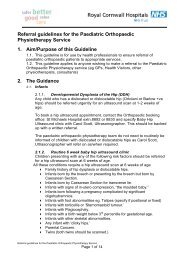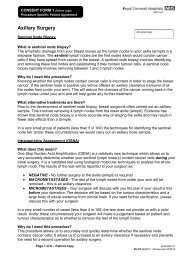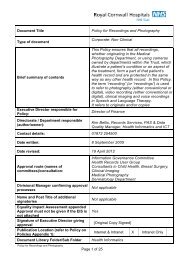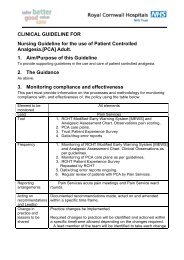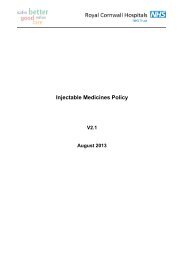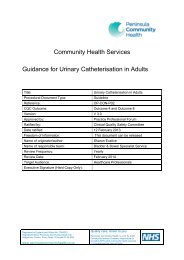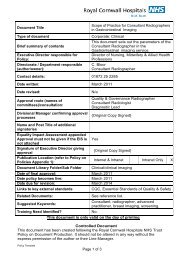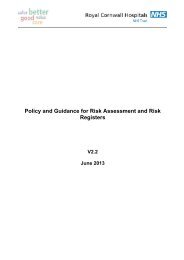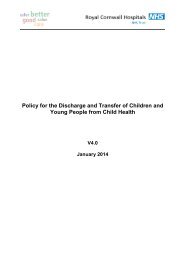Staff Slips Trips and Falls Policy
Staff Slips Trips and Falls Policy
Staff Slips Trips and Falls Policy
You also want an ePaper? Increase the reach of your titles
YUMPU automatically turns print PDFs into web optimized ePapers that Google loves.
Peninsula Community Health<br />
<strong>Staff</strong> <strong>Slips</strong>, <strong>Trips</strong> <strong>and</strong> <strong>Falls</strong> <strong>Policy</strong><br />
Title: <strong>Staff</strong> <strong>Slips</strong>, <strong>Trips</strong> <strong>and</strong> <strong>Falls</strong> <strong>Policy</strong><br />
Procedural Document Type: <strong>Policy</strong><br />
Reference: GOP23<br />
CQC Outcome: Outcome 14D<br />
Version: V2<br />
Approved by: Health & Safety Sub Committee<br />
Ratified by: Clinical Quality <strong>and</strong> Safety Committee<br />
Date ratified: 13 th March 2012<br />
Freedom of Information: This document can be released<br />
Name of originator/author: Health <strong>and</strong> Safety Team<br />
Name of responsible team: Health <strong>and</strong> Safety Team<br />
Review Frequency: Every 3 years unless change in legislation<br />
Review date: 13 th March 2015<br />
Target audience: All staff<br />
Registered in Engl<strong>and</strong> <strong>and</strong> Wales No: 7564579<br />
Registered office: Peninsula Community Health CIC,<br />
Sedgemoor Centre, Priory Road, St Austell PL25 5AS<br />
www.peninsulacommunityhealth.co.uk<br />
Quality care, closer to you<br />
Peninsula Community Health is a not for profit<br />
Community Interest Company responsible for<br />
providing NHS adult community health<br />
services<br />
in Cornwall <strong>and</strong> the Isles of Scilly
Contents<br />
1. Introduction………………………………………………………………………….3<br />
2. Definitions…………………………………………………………………………...3<br />
3. Duties <strong>and</strong> responsibilities ….……………………………………………… …..3<br />
4. <strong>Slips</strong>, <strong>Trips</strong> <strong>and</strong> <strong>Falls</strong> <strong>Policy</strong> information…………………………………………5<br />
4.1 Causes of <strong>Slips</strong>, <strong>Trips</strong> <strong>and</strong> <strong>Falls</strong>……………………………………………..5<br />
4.2 Preventing of <strong>Slips</strong>, <strong>Trips</strong> <strong>and</strong> <strong>Falls</strong>………………………………………….7<br />
4.3 Action to be taken in the event of a Slip, Trip or Fall……………………….8<br />
4.4 Working at Heights…………………………………………………………….8<br />
5. <strong>Policy</strong> Implementation…………………………………………………… ………11<br />
6. Process for monitoring effective implementation……………………………….11<br />
7. Associated Documentation………………………………………………………. 12<br />
8. References………………………………………………………………………….12<br />
Appendix A – Generic <strong>Staff</strong> Slip, Trip <strong>and</strong> Fall risk assessment<br />
Appendix B – Generic <strong>Staff</strong> Slip, Trip <strong>and</strong> Fall action plan<br />
Appendix C – Ladder <strong>and</strong> stepladder checklist<br />
Please Note the Intention of this Document<br />
The <strong>Slips</strong>, <strong>Trips</strong> <strong>and</strong> <strong>Falls</strong> <strong>Policy</strong> describes the organisation’s management arrangements for<br />
the prevention of slip trip <strong>and</strong> falls incidents that may adversely affect <strong>Staff</strong>.<br />
<strong>Slips</strong>, trips <strong>and</strong> falls accidents are responsible for many serious injuries including deaths,<br />
particularly in older people. Simple injuries can lead to complications such as<br />
thromboses <strong>and</strong> embolisms, which may be fatal.<br />
Slip trip <strong>and</strong> falls incidents are the largest single cause of Public <strong>and</strong> Employers Liability<br />
claims. Their prevention is very high on the Health <strong>and</strong> Safety Executives enforcement<br />
agenda. All healthcare employers need to underst<strong>and</strong> what constitutes a risk, how to identify<br />
them <strong>and</strong> how any significant risk may be eliminated or reduced.
1 Introduction<br />
Peninsula Community Health (PCH) recognises that slips trip <strong>and</strong> falls accidents are a very<br />
significant cause of harm to staff, patients <strong>and</strong> visitors.<br />
For the identification of patients who may be more likely to slip or fall <strong>and</strong> subsequent use of<br />
measures to minimise the likelihood of harm refer to <strong>Policy</strong> for the Management <strong>and</strong><br />
Reduction of Risk of <strong>Falls</strong> in Community Hospitals<br />
PCH is committed to the prevention <strong>and</strong> reduction of slip trip <strong>and</strong> fall incidents, this can be<br />
achieved by ensuring that the following are features of the organisation’s health <strong>and</strong> safety<br />
management arrangements:<br />
Safe design, specification <strong>and</strong> maintenance of all premises including internal <strong>and</strong><br />
external flooring <strong>and</strong> horizontal surfaces.<br />
Ensuring that the correct <strong>and</strong> most appropriate access equipment is used to prevent<br />
falls from height as identified through the risk assessment process.<br />
Use of risk assessments / risk based inspections to identify significant environmental<br />
<strong>and</strong> other risks or unsafe practices.<br />
Timely reporting of incidents <strong>and</strong> prompt investigation.<br />
Feedback <strong>and</strong> learning from incidents<br />
2 Definitions<br />
Slip. To slide accidentally causing the person to lose their balance. This is either<br />
corrected or causes a person to fall.<br />
Trip. To stumble accidentally over an obstacle, causing the person to lose their<br />
balance. This is either corrected or causes a person to fall.<br />
Fall. An event which results in the person coming to rest on the ground or another<br />
surface lower than the person, whether or not an injury is sustained.<br />
3 Duties <strong>and</strong> responsibilities<br />
This section includes an overview of individual roles <strong>and</strong> responsibilities for this<br />
policy.<br />
3.1 The Chief Executive / Board<br />
a) The Chief Executive of PCH, as Accountable Officer, is ultimately responsible for<br />
health <strong>and</strong> safety.<br />
b) The PCH Board will delegate responsibility for the implementation of safe working<br />
practices to Managers within the organisation.
3.2 Executive Directors<br />
a) Are responsible, delegated from the Chief Executive, for the health <strong>and</strong> safety at work of<br />
all employees, workers who include Contingent Workforce <strong>and</strong> Agency staff, patients,<br />
contractors, visitors <strong>and</strong> others.<br />
b) Should ensure that the organisation is fully compliant with the requirements of the Health<br />
& Safety at Work etc. Act 1974, all other relevant legislation <strong>and</strong> Codes of Practice,<br />
ensuring that support is given to all persons to whom responsibility has been delegated.<br />
c) Are responsible for ensuring risk assessments are in place <strong>and</strong> which they can delegate<br />
to trained staff but retain accountability.<br />
3.3 Locality Managers, Head of Services shall:-<br />
a) Be responsible for ensuring suitable <strong>and</strong> sufficient risk assessments are carried out <strong>and</strong><br />
documented within their own areas of responsibility.<br />
b) Have processes in place to monitor <strong>and</strong> review risk assessments.<br />
c) Ensure a winter maintenance plan is designed <strong>and</strong> Implemented when severe weather<br />
warnings are forecast for ice <strong>and</strong> snow, which includes gritting of high usage areas first<br />
<strong>and</strong> in extended adverse weather conditions ensure gritting is extended to other areas of<br />
lower risk.<br />
d) Ensure that all premises <strong>and</strong> external surfaces / areas leased by PCH are as safe as is<br />
reasonably practicable <strong>and</strong> do not present a hazard to <strong>Staff</strong>, Patients, Visitors <strong>and</strong> others<br />
using PCH sites<br />
3.4 Matrons, Team Leaders, Ward Managers, Business Managers shall ensure:-<br />
a) That suitable <strong>and</strong> sufficient documented risk assessments, covering staff <strong>and</strong> others,<br />
are undertaken <strong>and</strong> reviewed concerning the risks arising from slips, trips <strong>and</strong> falls<br />
including falls from height within their areas of responsibility.<br />
b) That significant risks that cannot be eliminated or reduced immediately should be placed<br />
on local Risk Registers.<br />
c) That they co-ordinate the implementation of the risk assessments <strong>and</strong> ensure that an<br />
action plan is prepared containing control measures to eliminate or minimise the risks of<br />
slips, trips <strong>and</strong> falls in that area.<br />
d) That slip, trip <strong>and</strong> falls incidents are reported on the Incident Reporting System <strong>and</strong><br />
investigated to identify the underlying trends <strong>and</strong> causes.<br />
e) Ensure that any reports of damaged floor surfaces are reported immediately to the<br />
Estates Department.<br />
f) That all their staff are up to date with training in the prevention of slips trips <strong>and</strong> falls.
g) That all their staff are provided with <strong>and</strong> using the correct <strong>and</strong> appropriate equipment to<br />
prevent falls when working at height<br />
h) Ensure that systems are in place to ensure that staff from other departments / external<br />
contractors are challenged if any doubt exists that they are not using the correct<br />
equipment when working in their ward/department.<br />
3.5 All <strong>Staff</strong><br />
All staff regardless of grade <strong>and</strong> occupation have a legal duty to abide by this <strong>Policy</strong> <strong>and</strong><br />
work safely at all times.<br />
In particular all staff will:-<br />
a) Behave in a safe <strong>and</strong> responsible manner, taking steps to avoid <strong>and</strong> reduce the risks of<br />
slips, trips <strong>and</strong> falls.<br />
b) Immediately inform line managers of any situation that is considered to be a significant<br />
risk <strong>and</strong> promptly report all health <strong>and</strong> safety incidents via the relevant incident reporting<br />
system.<br />
c) Report any damaged, broken or damaged floor surfaces, both internally <strong>and</strong> externally<br />
that pose a risk <strong>and</strong> require repair to their line manager.<br />
d) Ensure that tripping risks are not created – for example, locating wires <strong>and</strong> cables safely,<br />
not blocking designated walkways etc.<br />
e) Ensure that slipping risks are not created, for example cleaning spillages of liquids <strong>and</strong><br />
powder promptly or reporting leaks etc.<br />
f) Wear personal protective equipment as appropriate or if specified in the risk assessment.<br />
g) Attend all training courses arranged for them on slips, trips <strong>and</strong> falls.<br />
4 <strong>Staff</strong> <strong>Slips</strong>, <strong>Trips</strong> <strong>and</strong> <strong>Falls</strong> <strong>Policy</strong> Information<br />
4.1 Causes of Slip, Trip <strong>and</strong> <strong>Falls</strong><br />
The main causes of slips, trips <strong>and</strong> falls in the workplace include the following. Note all of<br />
these should be taken into account when carrying out a documented risk assessment:-<br />
4.1.1 Flooring<br />
Health Technical Memor<strong>and</strong>um (HTM) 61 – Flooring: This document outlines the<br />
requirements <strong>and</strong> specifications on building components for health buildings <strong>and</strong> should be<br />
referred to for new building work <strong>and</strong> alterations. Much of the information it contains is<br />
equally applicable to renewal of flooring in existing buildings.<br />
The floor in a workplace must be suitable for the type of work activity undertaken.<br />
Therefore it will be different in a ward, an office, a workshop <strong>and</strong> a kitchen.
Where a floor can not be kept dry, people should be able to walk on it without fear of<br />
slipping despite any contamination that may be on it. Flooring types will have<br />
different levels of “roughness”, this gives the flooring its non slip properties. It is<br />
possible to measure this roughness <strong>and</strong> it is determined by what is known as the<br />
coefficient of friction.<br />
A floor must be able to be cleaned correctly to ensure that it does not become<br />
slippery or that it keeps its slip resistance properties (if a non slip floor).<br />
The floor must be fitted correctly to ensure that there are no hazards <strong>and</strong> any non slip<br />
coatings are correctly applied. The floor must be maintained in good order to ensure<br />
that there are no trip hazards e.g. holes, uneven surfaces, badly fitted carpets at door<br />
thresholds or curled up carpet edges.<br />
Ramps, raised platforms <strong>and</strong> other changes of level should be avoided, if they can’t<br />
they must be highlighted.<br />
4.1.2 Stairs<br />
Stairs can potentially create a higher risk of slips trips <strong>and</strong> falls. To help to control this risk<br />
stairs should:-<br />
have high visibility, non slip, square nosings on the step edges, be fitted with a<br />
suitable h<strong>and</strong>rail <strong>and</strong> the steps should be of equal height <strong>and</strong> width.<br />
have adequate lighting.<br />
be kept clear <strong>and</strong> unobstructed <strong>and</strong> maintained in good condition, free of defective<br />
coverings or raised nosings etc.<br />
4.1.3 Contamination<br />
Prevent contamination <strong>and</strong> you reduce or even eliminate the slip risk as most floors only<br />
become slippery once they become contaminated.<br />
Contamination can be classed as anything that ends up on a floor e.g. rainwater, oil,<br />
grease, cardboard, product wrapping, dust etc. the list is endless. It can be a byproduct<br />
of a work process or be due to adverse weather conditions.<br />
If you are relying on the floor to be good enough to cope with the contamination <strong>and</strong><br />
still be non-slip you need to remember that the more viscous (the thicker) the<br />
contamination the rougher a floor needs to be in order for slips not to happen.<br />
4.1.4 Cleaning<br />
Cleaning affects every workplace, nowhere is exempt. It is not just a subject for GSA staff;<br />
everyone in the organisation has a job to do e.g. keeping your workspace clear; <strong>and</strong> dealing<br />
with your own spillages.<br />
The process of cleaning can create slip <strong>and</strong> trip hazards, especially for those<br />
entering the area being cleaned, for example, smooth floors left damp by a mop are<br />
likely to be extremely slippery <strong>and</strong> trailing wires from a vacuum or buffing machine<br />
can present a trip hazard. Stop pedestrian access to smooth wet floors by using<br />
barriers or cleaning in sections. Signs <strong>and</strong> cones only warn of a hazard, they do not<br />
prevent people from entering the area.<br />
An effective cleaning regime requires a good management system to help identify<br />
problem areas, decide what to do, check that the steps have been effective.<br />
Effective training <strong>and</strong> supervision is essential to ensure cleaning is undertaken to the<br />
correct st<strong>and</strong>ard. Domestic staff need to be informed of their duties <strong>and</strong> why the<br />
cleaning needs to be undertaken in a particular way or at a particular time. Lack of<br />
underst<strong>and</strong>ing can lead to inappropriate shortcuts.<br />
Contamination is implicated in almost all slip accidents. Regular <strong>and</strong> effective<br />
cleaning to remove contamination helps reduce accidents.
4.1.5 Human Factors<br />
How people act <strong>and</strong> behave in their work environments can affect slips <strong>and</strong> trips. A positive<br />
attitude toward health <strong>and</strong> safety, can reduce the risk of slip <strong>and</strong> trip accidents e.g. dealing<br />
with a spillage, instead of waiting for someone else to deal with it.<br />
Wearing the correct footwear while at work helps to prevent slips <strong>and</strong> trips for<br />
example people wearing high heels at work will make them more vulnerable to a slip.<br />
Distractions which prevent you from seeing or thinking about where you are going,<br />
can also increase the risk of an accident e.g. rushing about, carrying large objects or<br />
becoming distracted whilst walking e.g. using a mobile phone.<br />
Attitudes towards getting the job completed could result in incorrect or inappropriate<br />
equipment being used. This can lead to instances of slips, trips <strong>and</strong> falls. A typical<br />
example being a leaky or overfilled floor cleaner which sheds water inappropriately<br />
causing a slip, trip or fall hazard.<br />
4.1.6 Environmental Issues<br />
Environmental issues such as lighting (natural or otherwise), loud or unfamiliar noises, the<br />
weather, humidity, condensation etc can affect the risk of slips <strong>and</strong> trips, for example:<br />
Too much light on a shiny floor can cause glare <strong>and</strong> stop people from seeing hazards<br />
on floors <strong>and</strong> stairs.<br />
Too little light will also prevent people from seeing hazards on the floor <strong>and</strong> stairs.<br />
Unfamiliar <strong>and</strong> loud noises may be distracting.<br />
If rainwater gets onto a smooth surface inside of a building, it may create a slip<br />
hazard.<br />
Cold weather can cause frost <strong>and</strong> ice to form, which may create slippery surfaces.<br />
Condensation can make a smooth floor slippery.<br />
4.1.7 Footwear<br />
Where you can’t control footwear e.g. pedestrians using the hospital, it is vitally important to<br />
ensure that smooth floors are kept clean <strong>and</strong> dry.<br />
In the hospital, where work floors are mainly clean <strong>and</strong> dry the wearing of flat shoes<br />
or a low sensible heel, with the sole <strong>and</strong> heel made in a softer material providing<br />
some grip, can help reduce risks from slips <strong>and</strong> trips<br />
Where floors can’t be kept dry or clean e.g. food preparation, the right footwear will<br />
be particularly important, so a slip resistant shoe may be preferred.<br />
In areas where the organisation has introduced the need for slip resistant or special<br />
footwear, the footwear will be considered to be personal protective equipment <strong>and</strong><br />
will be subject to the requirements of the Personal Protective Equipment Regulations<br />
4.2 PREVENTING SLIPS, TRIPS AND FALLS<br />
4.2.1 Ensure that documented risk assessments are in place: these should be<br />
reviewed regularly <strong>and</strong> inspect internal <strong>and</strong> external areas that have the potential to pose a<br />
significant risk. Ensure risk assessments are amended to record the current findings. (See<br />
Appendix A <strong>and</strong> B for suggested risk assessment <strong>and</strong> action plan – this should be made site<br />
specific)
4.2.2 Contamination – Prevention <strong>and</strong> Control<br />
Prevent contamination getting on floor - remember a smooth, clean, dry floor, is rarely a<br />
slip risk.<br />
Control contamination - There are measures that can be put into place to help control<br />
contamination <strong>and</strong> to stop it from spreading into other areas of the workplace e.g. fit drip<br />
trays under racking that contains fluids; use mats at entrances etc;<br />
Design out problems - good design can also prevent contamination from getting onto the<br />
floor, e.g. fit canopies over entrances, <strong>and</strong> fix leaking machines.<br />
Review work activities - ensure good housekeeping practices, remember walkways must<br />
be kept clear, free from trailing wires <strong>and</strong> other contamination. Contamination comes in<br />
various forms: fluids, food <strong>and</strong> drink, polythene, cardboard. It is usually created by the work<br />
activity, so an assessment of the activity <strong>and</strong> way in which people work is essential e.g. are<br />
there enough waste bins? can the floor be cleaned in sections or out of hours?<br />
Employee & employer attitude - When it comes to contamination <strong>and</strong> housekeeping, staff<br />
attitude is important, spread the message, clean it up, rather than leave it to someone else.<br />
4.2.3 Adverse Environmental Conditions<br />
Check lighting is suitable <strong>and</strong> sufficient - it doesn’t matter how good the floor is if you<br />
can’t see where you are going.<br />
Is condensation a problem - on smooth floors only a tiny amount of liquid is required to<br />
cause a slip risk, so look out for condensation which could coat the floor, or humidity which<br />
would prevent the floor from fully drying out.<br />
Ice on pavements / paths / floors - during winter months, or where there are cold<br />
stores/freezers, ice may be a problem<br />
Rainwater able to enter building – can you fit canopies over doors, provide suitable<br />
matting at entrances to enable feet to be wiped. Fix leaking roofs.<br />
4.3 ACTION TO BE TAKEN IN THE EVEN OF A SLIP, TRIP OR FALL<br />
If a member of staff or a visitor falls on PCH premises, the following steps should be taken:<br />
Check the area first in order to safeguard your own safety<br />
An immediate assessment of any injury or harm should be done, taking action as<br />
necessary to make the individual safe <strong>and</strong> comfortable. When a fracture or serious<br />
harm is suspected, arrangements should be made for the person to attend A&E<br />
immediately.<br />
For minor injuries the person should be advised to see their GP or to attend the local<br />
minor injuries unit.<br />
Immediate action must be taken to make the area safe, clearing up fluids, spilt or<br />
broken items <strong>and</strong> any damaged / broken surfaces that pose a risk <strong>and</strong> require should<br />
be reported immediately to the Estates department.<br />
The incident should be reported using the relevant incident reporting system <strong>and</strong><br />
consideration given as to whether the incident is RIDDOR reportable (see Incident<br />
Management <strong>Policy</strong>).
4.4 WORKING AT HEIGHT<br />
4.4.1 Introduction<br />
<strong>Falls</strong> from height are the biggest cause of workplace deaths <strong>and</strong> one of the main causes of<br />
major injury in the country to-day. <strong>Falls</strong> from height are mostly associated with the<br />
construction industry but they can <strong>and</strong> do happen in all workforces <strong>and</strong> all workplaces,<br />
healthcare is no exception.<br />
Healthcare staff, like staff in other industries, have to carry out operational <strong>and</strong> maintenance<br />
tasks which are conducted at height. For example the estates <strong>and</strong> maintenance teams have<br />
to carry out repairs on buildings that involve roof repairs <strong>and</strong> gutter clearing, replacing<br />
light bulbs. Domestic staff have to replace curtains to large windows, bed spaces <strong>and</strong> to<br />
other ward <strong>and</strong> department areas which involve them working at heights.<br />
4.4.2 The Work at Height Regulations 2005 was introduced to ensure that management<br />
<strong>and</strong> staff always took a consistent safe approach to working at heights.<br />
The regulations define working at height as “Any place where a person could be injured<br />
when falling from it, even if it is at or below ground level”. The regulations impose duties <strong>and</strong><br />
responsibilities on PCH with the overriding principle that it must do all that is reasonably<br />
practicable to prevent anyone falling.<br />
The Regulations sets out a simple hierarchy for managing working at heights <strong>and</strong> in the<br />
selection of equipment for work at height.<br />
avoid work at height where they can;<br />
use work equipment or other measures to prevent falls where they cannot avoid<br />
working at height; <strong>and</strong><br />
where they cannot eliminate the risk of a fall, use work equipment or other measures<br />
to minimise the distance <strong>and</strong> consequences of a fall should one occur.<br />
4.4.3 Management Responsibilities for working at height<br />
Planning, you must:-<br />
ensure that no work is done at height if it is safe <strong>and</strong> reasonably practicable to do it<br />
other than at height;<br />
ensure that the work is properly planned, appropriately supervised, <strong>and</strong> carried out in<br />
as safe a way as is reasonably practicable;<br />
plan for emergencies <strong>and</strong> rescue;<br />
ensure that a risk assessment carried out <strong>and</strong> acted upon<br />
ensure where the risk of a fall cannot be eliminated, you use work equipment or other<br />
measures to minimize the distance <strong>and</strong> consequences of a fall should one occur.<br />
use work equipment or other measures to prevent falls where they cannot avoid<br />
working at height<br />
avoid work at height wherever you can<br />
ensure that the work is postponed while weather conditions endanger health or<br />
safety (this does not apply to emergency situations)
<strong>Staff</strong> Training:-<br />
ensure that everyone involved in the work is competent (or, if being trained, is<br />
supervised by a competent person).<br />
where other precautions do not entirely eliminate the risk of a fall occurring, you must<br />
(as far as it is reasonably practicable to do so) train those who will be working at<br />
height how to avoid falling, <strong>and</strong> how to avoid or minimize injury to themselves should<br />
they fall.<br />
Selection of equipment:-<br />
When selecting equipment for work at height you must:-<br />
Use the most suitable equipment;<br />
Give collective protection measures (eg guard rails) priority over personal protection<br />
measures (eg safety harnesses);<br />
Take account of the working conditions; <strong>and</strong> risks to the safety of all those at the place<br />
where the work equipment is to be used.<br />
Inspections:-<br />
‘Inspection’ is defined in the regulations as ‘such visual or more rigorous inspection by a<br />
competent person as is appropriate for safety, including any appropriate testing’.<br />
Ensure that each individual place at which work is to be done at height is checked on each<br />
occasion before that workplace is used.<br />
Ensure that any item such as Guardrails, toe boards, working platforms, fall arrest<br />
equipment (personal or collective), ladders or stepladders are inspected, after it is<br />
assembled <strong>and</strong> / or installed <strong>and</strong> as often as is necessary to ensure safety. In particular the<br />
inspection should make sure that any deterioration can be detected <strong>and</strong> remedied in good<br />
time.<br />
Fragile surfaces:-<br />
Ensure that no one working under your control goes onto or near a fragile surface unless<br />
that is the only reasonably practicable way for the worker to carry out the work safely, having<br />
regard to the dem<strong>and</strong>s of the task, equipment, or working environment.<br />
If anyone does have to work on or near a fragile surface the Project Manager/Site<br />
Manager must: do all that is reasonably practicable to make them aware of the danger,<br />
preferably by prominent warning notices <strong>and</strong> ensuring that suitable platforms, coverings, <strong>and</strong><br />
guard rails are provided <strong>and</strong> used to minimise the risk effect of a fall.<br />
Falling objects:-<br />
Take all reasonably practicable precautions to prevent injury caused by anything falling<br />
from height.<br />
Ensure that nothing is thrown or tipped from height if it is likely to cause injury or stored in<br />
such a way that its movement is likely to injure anyone.<br />
If the workplace contains an area in which there is a risk of someone being struck by a<br />
falling object, ensure that the area is clearly indicated <strong>and</strong>/or signed <strong>and</strong> that unauthorised<br />
people are denied entry.
Access equipment:-<br />
This is equipment that provides a person with the means to access places or objects<br />
which they would not have been able to access otherwise. Such equipment includes<br />
stepladders, ladders, scaffolding, tower platforms, scissor lifts <strong>and</strong> boomtype lifts (cherry<br />
pickers).<br />
It is essential that everyone involved in working with or from any of these types of access<br />
equipment can do their work safely, by having the knowledge <strong>and</strong> skills needed to carry out<br />
their work on a day to day basis.<br />
If using access equipment there should be safe access <strong>and</strong> egress to <strong>and</strong> from that<br />
equipment.<br />
The checklists shown at Appendix C will help to determine the knowledge <strong>and</strong> skills<br />
necessary for staff in the workplace if they use access equipment in their day-to-day work.<br />
4 <strong>Staff</strong> <strong>Slips</strong>, <strong>Trips</strong> <strong>and</strong> <strong>Falls</strong> <strong>Policy</strong> Implementation<br />
5.1 Implementation<br />
The implementation <strong>and</strong> effectiveness of this policy will be monitored through the<br />
Health <strong>and</strong> Safety Committee.<br />
5.2 Training <strong>and</strong> Support<br />
An e-learning package around <strong>Slips</strong>, <strong>Trips</strong> <strong>and</strong> <strong>Falls</strong> will be available to all staff. The HSE’s<br />
award winning Shattered Lives Campaign raises awareness about the risks of slips, trips<br />
<strong>and</strong> falls from height at work, <strong>and</strong> simple action to take to prevent these accidents from<br />
happening in the workplace http://www.hse.gov.uk/shatteredlives The HSE have also<br />
produced a slips <strong>and</strong> trips e-learning package called Watch Your Step<br />
http://www.hse.gov.uk.slips/step/start.htm which is suitable for employees, managers <strong>and</strong><br />
specialists. Learn about how slips <strong>and</strong> trips are caused, how to spot hazards, why<br />
preventing them is important <strong>and</strong> what you can do to tackle them. It is an interactive<br />
package that includes quizzes, animations <strong>and</strong> video <strong>and</strong> can run directly over the Internet.<br />
<strong>Staff</strong> are recommended to complete this package to improve their underst<strong>and</strong>ing of slips <strong>and</strong><br />
trips <strong>and</strong> to reduce accidents.<br />
5.3 Dissemination<br />
Once ratified this policy will be loaded to the intranet (read only).<br />
Confirmation of receipt is not required for this procedural document.<br />
5.4 Storing the Procedural Document<br />
The signed procedural document will be stored (hard copy) centrally, as will the digital (soft<br />
copy) version.
5.5 Equality Impact Assessment<br />
PCH aims to design <strong>and</strong> implement services, policies <strong>and</strong> measures that meet the diverse<br />
needs of our services, population <strong>and</strong> workforce, ensuring that none are placed at a<br />
disadvantage over others. As part of its development, this strategy <strong>and</strong> its impact on<br />
equality have been assessed. The assessment is to minimise <strong>and</strong> if possible remove any<br />
disproportionate impact on employees on the grounds of race, sex, disability, age, sexual<br />
orientation or religious belief. No detriment was identified.<br />
5 Process for Monitoring Effective Implementation<br />
The effective implementation of this policy will be monitored by the Health <strong>and</strong> Safety<br />
Committee. Spot checks will be undertaken by the Health <strong>and</strong> Safety Team to ensure<br />
compliance with the policy around the use of access equipment <strong>and</strong> the findings reported to<br />
the Health <strong>and</strong> Safety Committee. Slip, trip <strong>and</strong> fall incidents will be monitored through the<br />
incident reporting system <strong>and</strong> trends / themes analysed <strong>and</strong> reported back at the Locality<br />
Health <strong>and</strong> Safety meetings for discussion.<br />
6 Associated Documentation<br />
This document references the following supporting documents which should be<br />
referred to in conjunction with the document being developed:<br />
PCH Health & Safety Management Strategy<br />
PCH Health & Safety <strong>Policy</strong><br />
PCH Incident Management <strong>Policy</strong><br />
PCH Infection Control <strong>Policy</strong><br />
PCH <strong>Policy</strong> for the management <strong>and</strong> reduction of risk of falls in hospital care<br />
The Health <strong>and</strong> Safety at Work Act 1974<br />
Management of Health <strong>and</strong> Safety at Work Regulations 1992 (as amended 1999)<br />
Provision <strong>and</strong> Use of Work Equipment Regulations 1998<br />
Reporting of Injuries, Disease <strong>and</strong> Dangerous Occurrences Regulations 1995<br />
The Work at Height Regulations 2005<br />
7 References<br />
Work at Height Regulations 2005. Available at<br />
http://www.hse.gov.uk/falls/regulations.htm<br />
Useful resources from the Health <strong>and</strong> Safety Executive available at<br />
http://www.hse.gov.uk/shatteredlives
Hospital<br />
Health Office/clinic<br />
Item<br />
No<br />
1.<br />
Hazard<br />
Poor housekeeping<br />
in corridors / rooms /<br />
offices / general<br />
areas.<br />
2. Internal wet floor<br />
surface following a<br />
spillage.<br />
3. Internal slippery floor<br />
surface following<br />
cleaning<br />
Persons at<br />
risk<br />
<strong>Staff</strong><br />
Visitors<br />
Contractors<br />
Patients<br />
Office/ Area / Unit / Ward:<br />
Ext:<br />
Risk<br />
Type<br />
Slip, trip<br />
<strong>and</strong> fall<br />
injuries<br />
Existing control<br />
measures<br />
1. <strong>Staff</strong> awareness of good<br />
general housekeeping<br />
2. <strong>Staff</strong> awareness -<br />
personal belongings (bags,<br />
briefcases) are stored away<br />
safely<br />
All As above<br />
3. Items of equipment, boxes,<br />
packaging etc is<br />
removed/disposed of within<br />
a short time scale.<br />
1. Warning signs<br />
2. <strong>Staff</strong> awareness<br />
All As above<br />
3. Annual GSA Training –<br />
cleaning techniques,<br />
spillage procedure<br />
As 1, 2, 3 above<br />
APPENDIX A - STAFF GENERIC SLIP, TRIP & FALL RISK ASSESSMENT<br />
Assessors:<br />
Title:<br />
Numerical<br />
Risk<br />
Ranking<br />
Overall<br />
risk<br />
rating<br />
Impact Likely E, H,<br />
M , L *<br />
Assessment Date:<br />
Review Date:<br />
Summary of proposed added control<br />
measures<br />
1. Health, Safety <strong>and</strong> Risk m<strong>and</strong>atory<br />
training<br />
2. Local staff Induction<br />
3. Visual ad hoc housekeeping<br />
inspection / audit take place<br />
regularly<br />
1. Ensure warning signs are easily<br />
accessible <strong>and</strong> available.<br />
2. Spillage procedure available for<br />
staff<br />
1. Ensure cleaning is undertaken<br />
outside peak periods<br />
Risk<br />
Register<br />
Ref. No.<br />
(for use by<br />
Managers
Item<br />
No<br />
Hazard<br />
4. Internal - uneven<br />
floor coverings<br />
i.e. damaged /<br />
poor condition<br />
/worn surfaces<br />
5. Trailing electrical<br />
cables / phone<br />
wires in offices /<br />
reception areas<br />
Persons at<br />
risk<br />
Risk<br />
Type<br />
All <strong>Slips</strong>,<br />
trips <strong>and</strong><br />
fall<br />
injuries<br />
All staff<br />
Contractors<br />
Existing control<br />
measures<br />
1. <strong>Staff</strong> awareness<br />
2. Warning signs<br />
3. Incident reporting system<br />
– potential near miss<br />
As above 1. Cables / wiring to be<br />
covered or placed out of<br />
sight<br />
6. Staircases All As above 1. Stairs must be kept free<br />
from obstructions at all<br />
times.<br />
7 Uneven/ poor<br />
condition /<br />
damaged<br />
external surfaces<br />
i.e. , pavements,<br />
potholes, manhole<br />
covers, steps<br />
8. External -<br />
Icy/snowy<br />
entrances, slopes,<br />
steps, carpark<br />
areas.<br />
All As above 1. <strong>Staff</strong> awareness<br />
2. Display warning signs<br />
3. Incident reporting system<br />
– potential near miss<br />
All As above 1. <strong>Staff</strong> awareness<br />
2. Monitoring of inclement<br />
weather<br />
Numerical<br />
Risk<br />
Ranking<br />
Overall<br />
risk<br />
rating<br />
Impact Likely E, H,<br />
M , L *<br />
Summary of proposed added control<br />
measures<br />
1. Warning signs are visible <strong>and</strong><br />
accessible<br />
2. Flooring hazards to be reported -<br />
Line Manager / Supervisor / Estates<br />
for remedial action<br />
3. Ensure any accidents / incidents are<br />
reported via Incident reporting system<br />
1. Visual ad hoc housekeeping<br />
inspection / audit be implemented<br />
1. Provision of h<strong>and</strong>rails<br />
2. Suitable lighting is provided<br />
1. Report Line Manager / Supervisor /<br />
Estates for remedial action<br />
2. Ensure any accidents / incidents are<br />
reported via Incident reporting system<br />
1. Ensure ‘inclement weather ‘plan in<br />
place<br />
Risk<br />
Register<br />
Ref. No.<br />
(for use by<br />
Managers
APPENDIX B - STAFF GENERIC SLIP, TRIP & FALL ACTION PLAN<br />
Healthcare premises<br />
Office/ Area / Unit / Ward:<br />
Ext:<br />
Risk<br />
Assessment<br />
Item No*<br />
Hazard*<br />
1 Poor housekeeping<br />
in corridors / rooms /<br />
offices / general<br />
areas.<br />
2<br />
Internal wet/slippery<br />
floor surfaces<br />
following a spillage<br />
Action to be implemented to improve control<br />
of risk<br />
1. Information <strong>and</strong> training<br />
.Ensure:<br />
- All staff attend Health, Safety <strong>and</strong> Risk<br />
m<strong>and</strong>atory training<br />
- new / returning to work staff are provided with<br />
local induction<br />
- staff have been provided with Security<br />
protocol<br />
2. All staff training is documented <strong>and</strong><br />
evidenced.<br />
3. Visual ad hoc housekeeping inspection take<br />
place regularly<br />
1. Implement <strong>and</strong> ensure staff are aware<br />
spillage of procedure<br />
2. Ensure warning signs are easily accessible<br />
<strong>and</strong> available<br />
3. Check floor surfaces for condition, suitability,<br />
fit for purpose<br />
Assessors:<br />
Title:<br />
Responsible<br />
Person(s)<br />
Timescale<br />
Assessment Date:<br />
Review Date:<br />
Revised numerical<br />
Risk Ranking<br />
(to be assessed &<br />
reviewed as action<br />
progresses / completes)<br />
Overall<br />
residual<br />
risk<br />
rating<br />
Impact Likely E, H,<br />
M , L<br />
Risk<br />
Register<br />
ref. No. (for<br />
use by<br />
Managers)
STAFF GENERIC SLIP, TRIP & FALL ACTION PLAN<br />
Risk<br />
Assessment<br />
Item No*<br />
Hazard*<br />
3 Internal slippery floor<br />
surfaces following<br />
cleaning<br />
4<br />
5<br />
Internal uneven floor<br />
coverings i.e.<br />
damaged / worn /<br />
poor condition<br />
surfaces<br />
Trailing electrical<br />
cables / phone wires<br />
in offices / reception<br />
area<br />
Action to be implemented to improve control<br />
of risk<br />
1. Ensure cleaning is undertaken outside peak<br />
periods<br />
2. Monitor <strong>and</strong> review as appropriate<br />
1. Ensure warning signs are visible <strong>and</strong> staff are<br />
made aware of potential slip, trip <strong>and</strong> fall near<br />
miss<br />
2. Report worn / damaged surfaces to line<br />
manager immediately to ensure prompt repair<br />
via Estates.<br />
3. Ensure any accidents / incidents / near misses<br />
are reported via Incident reporting system.<br />
Monitor incidents/statistics<br />
4. Report to Line Manager / Estates for remedial<br />
action<br />
5. Consider raising at appropriate H&S Locality<br />
group<br />
1. Monthly visual audit of office spaces to be<br />
implemented.<br />
2. Cable management to be considered when<br />
occupying new offices / environments<br />
Responsible<br />
Person(s)<br />
Timescale<br />
Revised numerical<br />
Risk Ranking<br />
(to be assessed &<br />
reviewed as action<br />
progresses / completes )<br />
Overall<br />
residual<br />
risk<br />
rating<br />
Impact Likely E, H,<br />
M , L<br />
Risk<br />
Register<br />
ref. No. (for<br />
use by<br />
Manages/
STAFF GENERIC SLIP, TRIP & FALL ACTION PLAN<br />
Risk<br />
Assessment<br />
Item No*<br />
Hazard*<br />
Action to be implemented to improve control<br />
of risk<br />
6 Staircases 1. Ensure h<strong>and</strong>rails provided <strong>and</strong> securely fitted<br />
7 Uneven/ poor condition<br />
/ damaged external<br />
surfaces i.e. ,<br />
pavements , potholes,<br />
manhole covers, steps<br />
8 Icy/snowy external<br />
entrances, slopes,<br />
steps, car park areas<br />
2. Regular visual check of lighting to ensure good<br />
working order suitable level of lighting. Report any<br />
lighting defects promptly to Line Manager /<br />
Supervisor / Estates<br />
3. Ensure stair coverings are in good condition<br />
1. Ensure warning signs displayed<br />
2. Report immediately to Estates to ensure<br />
barriers/separation as appropriate to protect staff ,<br />
patients, visitors <strong>and</strong> others from hazard<br />
3. Report to Line Manager / Estates for remedial<br />
action<br />
4. Ensure any accidents / incidents / near misses are<br />
reported via Incident reporting system. Monitor<br />
incidents/statistics<br />
5. Consider raising at appropriate H&S Locality group<br />
1. Ensure ‘inclement weather’ plan in place i.e.<br />
- Estates / GSA’s involvement<br />
- grit, salt, s<strong>and</strong>, shovels available / accessible<br />
- priority clearing / no access areas<br />
- shared with staff<br />
2. Ensure slippery surfaces / black ice / uneven<br />
surfaces are well signposted.<br />
- Public <strong>and</strong> contactor awareness<br />
Responsible<br />
Person(s)<br />
Timescale<br />
Revised numerical<br />
Risk Ranking<br />
(to be assessed &<br />
reviewed as action<br />
progresses / completes )<br />
Overall<br />
residual<br />
risk<br />
rating<br />
Impact Likely E, H,<br />
M , L<br />
Risk<br />
Register<br />
ref. No. (for<br />
use by<br />
Managers)
Appendix C<br />
LADDER AND STEPLADDER CHECKLIST<br />
Common causes of ladder falls<br />
Over reaching<br />
Ladder in poor condition<br />
Ladder not suitable for the work<br />
1. Is the ladder right for the job Yes / No Comments<br />
Is the job low risk<br />
Is the work of short duration<br />
Is a stability device or st<strong>and</strong> required<br />
2. Is the ladder up to the job Yes / No Comments<br />
Is it long enough to reach the work easily<br />
Can it be placed securely on the surface<br />
Can you maintain three points of contact (leaning ladder)<br />
Can the ladder be set up at the right angle<br />
Is the surface it is leaning on secure<br />
Is it of the right classification (trade – industrial)<br />
3. Is the ladder in good condition Yes / No Comments<br />
Check stiles <strong>and</strong> rungs or steps<br />
Check the feet – are they missing, loose, damaged, worn<br />
Are rivets in place <strong>and</strong> secure<br />
Check locking bars on stepladders are not bent or<br />
buckled<br />
4. Do you know how to set up the ladder Yes / No Comments<br />
Do you know the correct angle for use<br />
Do you know how to use any stability devices<br />
Can you secure or tie the ladder at the top or bottom<br />
5. Using the ladder safely Yes / No Comments<br />
Make sure there are three points of contact available<br />
(leaning ladder)<br />
Do not over reach<br />
If you need to carry tools <strong>and</strong> equipment, make sure you<br />
do this safely<br />
Make sure you know the maximum safe loads on the<br />
ladder<br />
Always position the ladder face on to the work<br />
Make sure any locking bars are I the proper position<br />
Wear the right footwear <strong>and</strong> make sure the soles are<br />
clean<br />
Footing the ladder – do you know how best to do it <strong>and</strong><br />
that it is the last option?<br />
Working near people <strong>and</strong> near doors – have you made<br />
the area safe – ie warning signs, second person lookout<br />
6. Looking after the ladder Yes / No Comments<br />
Check ladder has unique identifying number for checking<br />
<strong>and</strong> inspection purposes<br />
Is the ladder stored safely<br />
Can you transport the ladder safely<br />
Ensure the rungs are kept clean




